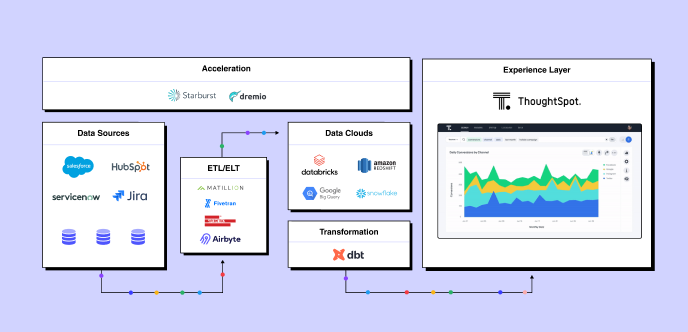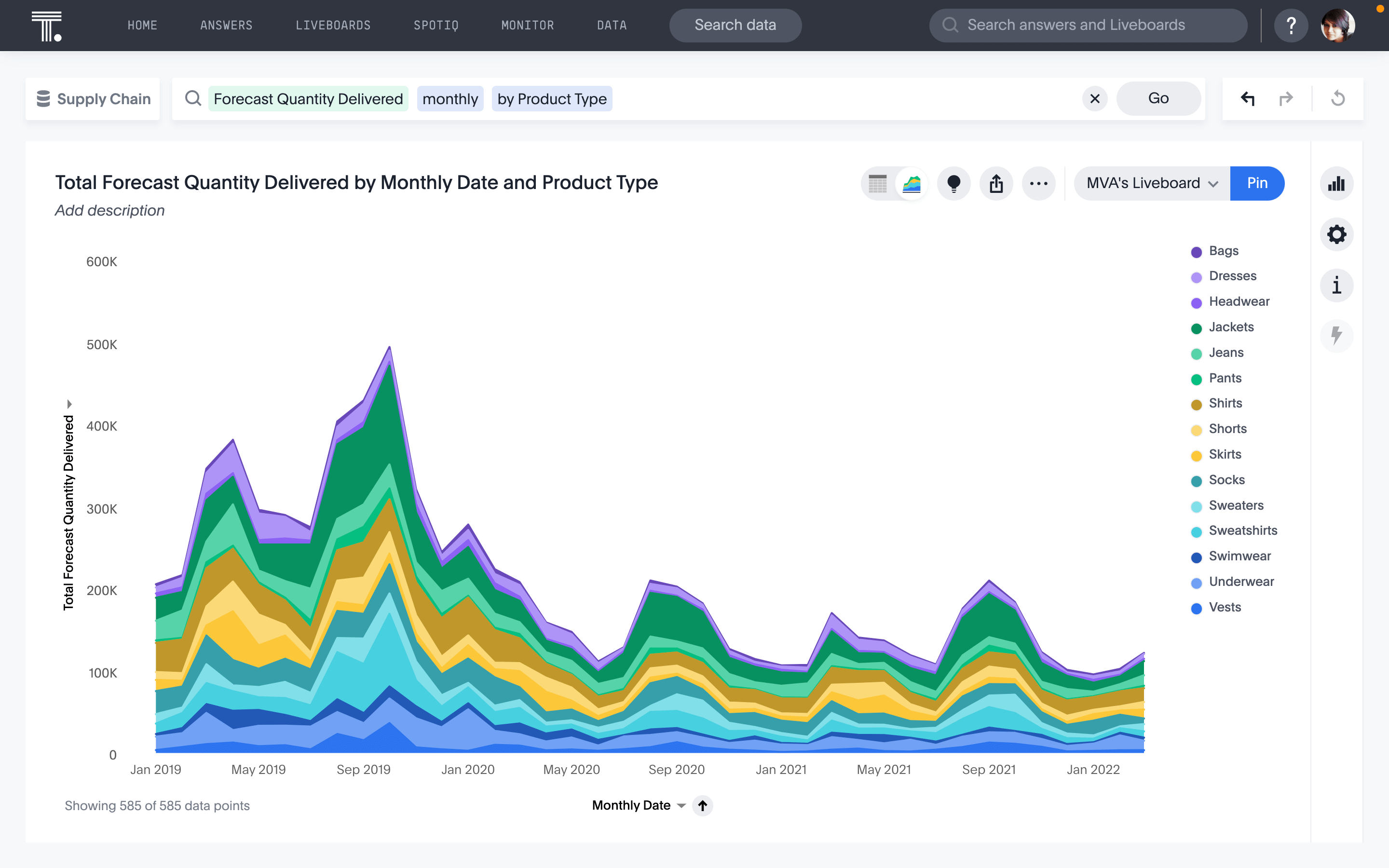The definition of business analytics
Business analytics is the practice of analyzing and interpreting data to gain insights into business performance and identifying areas for improvement.
This process can be enhanced with the use of various techniques and tools, such as predictive analytics, machine learning, and natural language processing, which empower analysts and business users to glean insights from structured and unstructured data sources.
Business analytics is used in almost every industry across a variety of roles. However, the goal is always the same—business analytics is used to uncover patterns, trends, correlations, and other insights that can be used to make decisions, improve processes, and inform strategic planning. By leveraging business analytics, companies and their teams can make data-driven decisions rather than relying on intuition or gut feeling.
Building a data analytics stack for business analytics
In order to create an accurate, real-time business analysis, you need to have clean, accessible data. That’s why building a modern data analytics stack is an essential first step to having business analytics.
A modern data analytics stack consists of a variety of business intelligence tools and cloud data technologies that collect, process, store, and analyze data. You can break these tools up into five essential components or layers:

1. Data sources
2. Extract and load tools
4. Transformation tools
5. Experience and analytics layer
This collection of tools cleans, organizes, and stores your data so that it is readily accessible for business analytics.
Why is business analytics important?
Business analytics is crucial to the success of any organization, as it helps organizations make informed decisions and drive performance. By leveraging data-driven insights, businesses can optimize their processes for cost savings, improve customer experience, identify new opportunities for growth, and even predict future trends and anticipate customer needs.
See how Capital One uses business analytics to power their success:
Benefits of business analytics
Improved decision-making
Business analytics helps organizations make better decisions by providing data-driven insights into customer needs, competitor strategies, and other market trends. With the help of analytics, businesses can identify areas for improvement and develop actionable plans for achieving their strategic goals.
Cost savings
By leveraging business analytics tools and techniques, businesses can gain visibility into their processes and identify areas for cost savings. This helps organizations reduce operational costs and optimize resources to achieve maximum efficiency.
Enhanced customer experience
Business analytics allows companies to understand customer needs better, preferences, and behaviors which helps them develop products or services that meet their expectations. Additionally, it provides insights into customer satisfaction and helps companies identify areas for improvement.
Increased efficiency
By using AI-powered business analytics, decision-makers are better equipped with insights to optimize their processes and allocate resources more efficiently. This helps organizations reduce waste and maximize productivity.
Improved strategic planning
Business analytics provides insights into market trends, competitor strategies, and other important metrics that can inform strategic planning. By leveraging data-driven insights, businesses can develop more effective analytics strategies better suited to the current market conditions.

Business analytics vs data analytics vs business intelligence
Although they are often used interchangeably, there are significant differences between business analytics, data analytics, and business intelligence. Each of these functions plays a vital role in delivering real-time data insights—let’s break it down below:
Data analytics occurs during the data extraction, load, and transformation layers of the modern data stack. This process typically involves a data analyst preparing large quantities of data for analysis.
Business intelligence occurs in the interaction layer, using data visualizations to show the past and present state of specific data sets.
Business analytics is the final step. This is where analytics engineers and domain experts apply their business knowledge to the business intelligence in order to make data-driven decisions.
4 types of business analytics
1. Descriptive analytics:
Descriptive analytics is used to summarize past data and understand what has happened. It involves examining historical data to gain insights into customer behavior, identify trends, and uncover key performance indicators.
This is the most fundamental and accessible type of business analytics—you can think of this as analyzing a standard dashboard, spreadsheet, or chart. It literally describes the data, like a KPI or the number of sales for a store.
2. Diagnostic analytics
Diagnostic analytics takes descriptive analytics a step further by using data mining techniques to look for patterns and uncover correlations. This type of data analytics technique can be used to identify the root cause of a problem, discover opportunities, and understand how changes affect other areas of the business.
This is where interactive Live Analytics comes into play. Diagnostic analytics requires the ability to drill down into the data to understand correlation and causation. Without interactive analytics, users end up making ad-hoc requests.
3. Predictive analytics
Predictive analytics uses data modeling techniques such as machine learning and artificial intelligence to anticipate future events or trends. This type of analytics can be used to forecast future customer behavior, anticipate market trends, and plan for possible scenarios.
Predictive analytics and machine learning features are not available in your standard dashboard. While some try to achieve this type of analysis with excel algorithms or “gut-feelings,” having a clear picture of your future demand, for example, can be invaluable for planning and projections.
4. Prescriptive analytics
Prescriptive analytics takes predictive analytics a step further by suggesting potential actions and outcomes. It helps business users decide which strategies to pursue, how to optimize operations, and which investments to make. Prescriptive analytics can also be used to provide personalized recommendations to customers.
Imagine if you received a notification that a retail location was underperforming this month, and weren’t on track to meet quarterly quota. With the addition of prescriptive analytics, the analysis could trigger a workflow in salesforce for a representative to contact the retail location to discuss the issue proactively. It might even offer prompts with strategies that recently boosted sales.
As you can see, all four types of business analytics are important for making informed decisions and gaining valuable insights into customer behavior, market trends, and operational efficiencies. By combining the power of these four types of analytics, businesses can gain a comprehensive view of their operations and make better decisions that positively impact the bottom line.
Why companies are switching to self-service business analytics
In order to truly democratize data and ensure every business user is empowered to make data-driven decisions, many companies are moving towards self-service analytics. In short, self-service analytics allows users to access and analyze data without relying on IT or BI specialists for support.
As noted in a study by the Harvard Business Journal, there are many benefits to self-service analytics. In fact, 72% of survey respondents say that productivity increased by empowering their front-line workers with data and analytics. Other benefits include customer engagement/satisfaction, employee engagement and satisfaction, product or service quality, and increased innovation.

As noted in a study by the Harvard Business Journal, there are many benefits to self-service analytics. In fact, 72% of survey respondents say that productivity increased by empowering their front-line workers with data and analytics. Other benefits include customer engagement/satisfaction, employee engagement and satisfaction, product or service quality, and increased innovation.
See how Cigna is using self-service analytics to empower their front-line users:
Find valuable insights in minutes
Business analytics software gives you the power to take control of your company’s destiny. The ability to access, quantify, and interpret data is becoming increasingly important in the business world.
In fact, 84% of the Harvard Business Journal’s survey respondents say their organization will be more successful when frontline workers are empowered to make important decisions in the moment. By understanding what business analytics is, how it works, the benefits it can offer your organization, and the different types of business analytics available, you’re well on your way getting ahead of the curve.
Ready to start using business analytics in your decision-making? ThoughtSpot gives you the power of artificial intelligence-driven analysis without needing a team of PhDs. Sign up for a free trial today, and see how easy it is to get started with business analytics.








